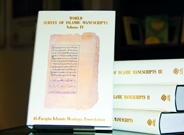The ‘World Collections’ databank / collection
holds the digitised outcome of the survey on the collections of Islamic
manuscripts in the world, completed and published by the Al-Furqan Foundation
in 1994, under the title “The World Survey of Islamic Manuscripts”.. This Survey is available
in both the English and Arabic language.
This flagship project (the only one of this type to date) started in
1989, focusing on identifying and recording undocumented Islamic manuscript
collections in the world, with the aim to support and instigate research into
the field of Islamic manuscripts. A
number of known scholars and
experts contributed to this encyclopaedic work.
The Survey identified collections in 106 countries. It is a
compilation of detailed independent studies, highlighting just over a million
and a half Islamic manuscripts from just over 2,500 collections. These
collections, in more than 40 languages, belong to public and private libraries
in almost 1,300 cities. It gathered
extensive information about these libraries, including details about their
establishment and the status of their collections, unveiling in the process
rare manuscripts. For example, the
collection of manuscripts at the Institute of Oriental Culture (University of
Tokyo) - that was acquired in 1987 - included several new and unique Islamic
manuscripts. The noteworthy discoveries
were two copies of Risala fi anwaʿ
al-mashruʿat, a comprehensive work on the terminology of jurisprudence, by
Luṭf Allah al-Kaydani (died 1349 AD /750 AH). These were significant findings,
as they had not even been mentioned in the most renowned classical period
references, such as Brockelmann's famous work Geschichte der Arabischen Litteratur (GAL), Sezgin's Geschichte Des Arabischens Schriftums (GAS), and Kaḥḥala's Muʿjam al-muʾallifin.
A large number of the identified libraries have listed and included
detailed descriptions about the manuscripts held in their collection, in a form
of a document or publication. This publication is known as a ‘catalogue’; with
most of them published and available for purchase. Another form of a published catalogue is one
that was compiled by a group of libraries, known as ‘library consortium’. These
libraries partnered to combine their collections into one unified published
catalogue, known as a ‘union catalogue’.
Some libraries held collections that were not catalogued or
documented. Others made an attempt to
describe their collections in simplified lists and general documentations. These were usually not published and are
known as ‘unpublished catalogues’.
A unique outcome of the Survey was the identification of all the
various catalogues. Just over 5,500 catalogues of Islamic manuscripts were
surveyed, including the listing of almost 700 union catalogues, and almost
1,000 unpublished catalogues.
All
this information and much more is ready to be explored on theAl-Furqan Digital Library, under the ‘World Collections’ databank.

